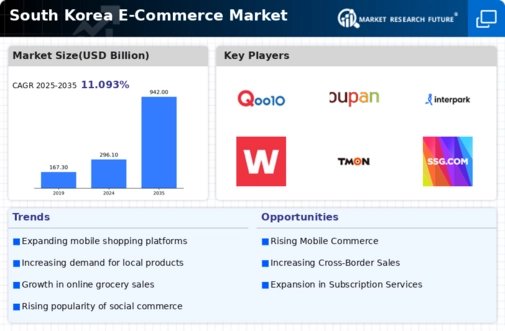Expansion of Logistics and Delivery Services
The The e-commerce market in South Korea is significantly influenced by the expansion of logistics and delivery services. With the increasing demand for rapid delivery, companies are investing heavily in logistics infrastructure. As of 2025, the market for logistics services is projected to grow by 15% annually, driven by consumer expectations for same-day or next-day delivery. This growth is prompting e commerce businesses to enhance their supply chain capabilities, ensuring that products reach consumers efficiently. Additionally, partnerships with local courier services and the implementation of advanced tracking systems are becoming commonplace. Such improvements in logistics are likely to enhance customer satisfaction and retention, thereby propelling the e commerce market forward.
Technological Advancements in Payment Systems
The The e-commerce market in South Korea is experiencing a notable transformation due to advancements in payment technologies. The integration of mobile wallets, contactless payments, and biometric authentication is enhancing the consumer experience. As of 2025, approximately 70% of online transactions are conducted through mobile devices, indicating a shift towards convenience and security. This trend is likely to continue, as consumers increasingly prefer seamless payment options. Furthermore, the rise of fintech companies is fostering innovation in payment solutions, which may lead to increased competition and lower transaction fees. Such developments are expected to drive growth in the e commerce market, as businesses adapt to meet consumer demands for faster and more secure payment methods.
Influence of Social Media on Consumer Behavior
The The e-commerce market in South Korea is significantly influenced by social media platforms, which are shaping consumer behavior and purchasing decisions. As of 2025, approximately 60% of consumers report discovering new products through social media channels. This trend indicates that social media is not merely a communication tool but a vital component of the shopping journey. Influencer marketing is particularly effective, as consumers tend to trust recommendations from individuals they follow. Consequently, e commerce businesses are increasingly collaborating with influencers to reach target audiences. This strategy is likely to enhance brand visibility and drive sales, thereby contributing to the overall growth of the e commerce market.
Rising Internet Penetration and Smartphone Usage
The The e-commerce market in South Korea is benefiting from the rising internet penetration and smartphone usage. As of November 2025, internet penetration stands at approximately 98%, with smartphone ownership exceeding 90% among the population. This high level of connectivity facilitates online shopping, as consumers can access e commerce platforms anytime and anywhere. The proliferation of high-speed internet and affordable data plans further supports this trend, enabling seamless browsing and purchasing experiences. Consequently, businesses are increasingly optimizing their websites and applications for mobile use, which is likely to attract a broader customer base. This growing accessibility is expected to continue driving the e commerce market in South Korea.
Consumer Preference for Personalized Shopping Experiences
The The e-commerce market in South Korea is increasingly shaped by consumer preferences for personalized shopping experiences. As consumers become more discerning, they seek tailored recommendations and customized offerings. Data analytics and artificial intelligence are being leveraged by e commerce platforms to analyze consumer behavior and preferences, allowing for more effective targeting. Reports indicate that personalized marketing can increase conversion rates by up to 30%. This trend suggests that businesses that invest in personalization strategies may gain a competitive edge in the e commerce market. Furthermore, the integration of augmented reality and virtual fitting rooms is enhancing the shopping experience, making it more engaging and interactive for consumers.





















Leave a Comment